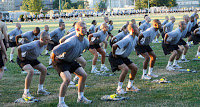Who does not respond to injury prevention warm-up programs? A secondary analysis of trial data from neuromuscular training programs in youth basketball, soccer and physical education.
Anu M. Räisänen, Jean-Michel Galarneau, Carla van den Berg, Paul Eliason, Lauren C. Benson, Oluwatoyosi B.A. Owoeye, Kati Pasanen, Brent Hagel, and Carolyn A. Emery. Journal of Orthopaedic & Sports Physical Therapy 0 0:0, 1-28
Take-Home Message
While injury prevention neuromuscular training warm-up programs effectively reduce someone’s risk of injury, not everyone reaps the same rewards. Females and youth with a history of injury during the prior year are more likely to be non-responders to these programs.
Background
Preventative neuromuscular training programs can effectively decrease an active person’s chance of injury. However, these programs may be more effective when individualized to a person’s physical abilities and characteristics.
Study Goal
Räisänen and colleagues conducted a secondary analysis of data of young active individuals (11-18 year olds) who performed a neuromuscular training warm-up program during one of four previous clinical trials. They investigated if differences in adherence to these programs related to non-response to the program (injury) and which factors related to non-response.
Methods
The authors used data collected during four trials (1793 participants), including high school basketball (18-week intervention), community soccer (20 weeks), and two separate junior high school physical education studies (12-14 weeks). The authors examined age, sex, body mass index (BMI), height, weight, lower limb dominance, and balance. They also monitored participants for injuries throughout the season, number of warm-up sessions completed, number of weeks completed of the warm-up, and sport participation or exposure. The warm-up programs were all 15 minutes long and tailored based on the sport or class. All warm-ups included an aerobic and balance component. However, basketball included static and dynamic stretching, while the other 2 only used dynamic stretching. Additionally, soccer and PE class incorporated various strengthening exercises, and soccer was the only warm-up to include agility.
Results
The authors found that females and participants with a history of injury during the prior 12 months were more likely to be non-responders to a neuromuscular training warm-up. Additionally, greater weekly adherence to the warm-up reduced the chance of injury in soccer only.
Viewpoints
Fifteen-minute neuromuscular training warm-up programs reduce the risk of injury in organized sports activities and general physical education courses. Consistent with the existing literature, the authors demonstrated the importance of adherence (performing the program more times each week) in reducing the risk of injury among soccer players. However, adherence may be less relevant in basketball and junior high physical education classes. The authors also found that females and those with a prior injury were more likely to be non-responders than males and those without a prior injury, respectively. We should avoid suggesting that females or those with a history of injury will not benefit from these programs because they may – just less than their peers. Instead, we should find ways to optimize these programs for these populations. We also need to notice that the authors examined all injuries, not just lower extremity injuries, as these programs are typically designed. So it is possible a “non-responder” in the study was a “lower extremity responder” if they had suffered an upper extremity or another injury.
Clinical Implications
Clinicians should encourage using neuromuscular training programs and consider how they may be tailored better for females or those with a history of injury.
Questions for Discussion
Would an “a la carte” approach work for those identified as high risk? Meaning, could an overall warm-up be created with a few extra movements added specifically to those participating that are considered high risk?
Written by Shelly Fetchen DiCesaro
Reviewed by Jeffrey Driban
Related Posts
Coaching the Coach, Get ACL Injury Prevention Programs to Stick!|
Sending Injury Prevention Programs Back to School
Forget about 7-minute Abs. How about the 10-Minute Lower Extremity Injury Prevention Program?

